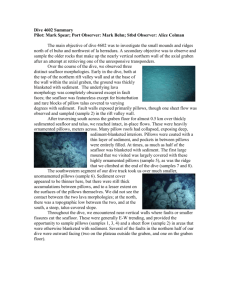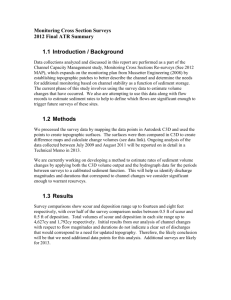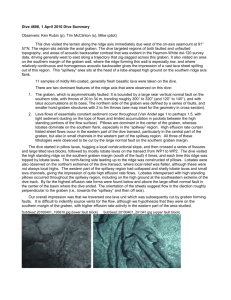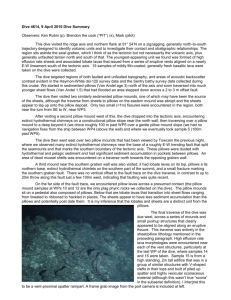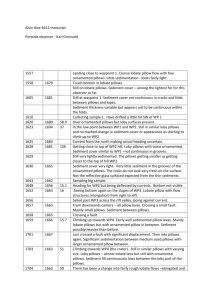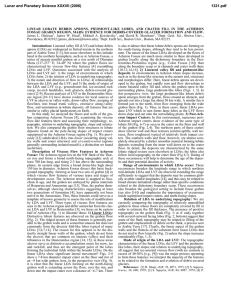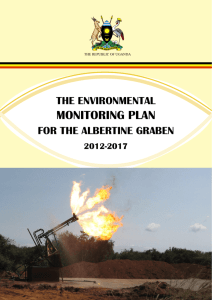Dive 4610 Summary
advertisement
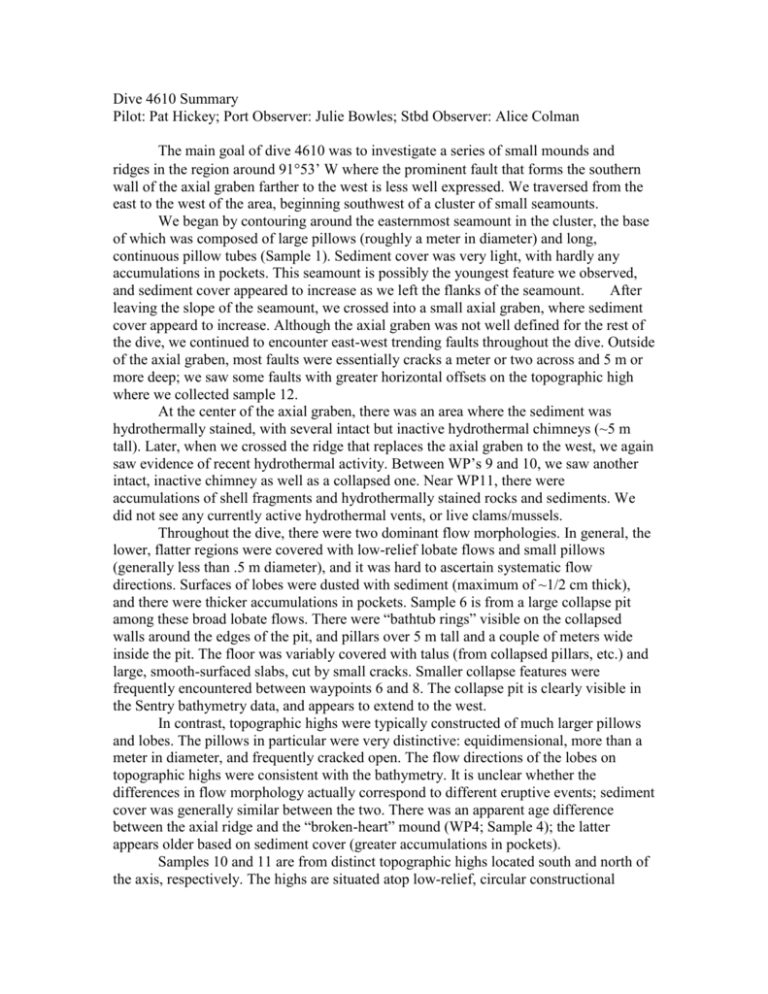
Dive 4610 Summary Pilot: Pat Hickey; Port Observer: Julie Bowles; Stbd Observer: Alice Colman The main goal of dive 4610 was to investigate a series of small mounds and ridges in the region around 9153’ W where the prominent fault that forms the southern wall of the axial graben farther to the west is less well expressed. We traversed from the east to the west of the area, beginning southwest of a cluster of small seamounts. We began by contouring around the easternmost seamount in the cluster, the base of which was composed of large pillows (roughly a meter in diameter) and long, continuous pillow tubes (Sample 1). Sediment cover was very light, with hardly any accumulations in pockets. This seamount is possibly the youngest feature we observed, and sediment cover appeared to increase as we left the flanks of the seamount. After leaving the slope of the seamount, we crossed into a small axial graben, where sediment cover appeard to increase. Although the axial graben was not well defined for the rest of the dive, we continued to encounter east-west trending faults throughout the dive. Outside of the axial graben, most faults were essentially cracks a meter or two across and 5 m or more deep; we saw some faults with greater horizontal offsets on the topographic high where we collected sample 12. At the center of the axial graben, there was an area where the sediment was hydrothermally stained, with several intact but inactive hydrothermal chimneys (~5 m tall). Later, when we crossed the ridge that replaces the axial graben to the west, we again saw evidence of recent hydrothermal activity. Between WP’s 9 and 10, we saw another intact, inactive chimney as well as a collapsed one. Near WP11, there were accumulations of shell fragments and hydrothermally stained rocks and sediments. We did not see any currently active hydrothermal vents, or live clams/mussels. Throughout the dive, there were two dominant flow morphologies. In general, the lower, flatter regions were covered with low-relief lobate flows and small pillows (generally less than .5 m diameter), and it was hard to ascertain systematic flow directions. Surfaces of lobes were dusted with sediment (maximum of ~1/2 cm thick), and there were thicker accumulations in pockets. Sample 6 is from a large collapse pit among these broad lobate flows. There were “bathtub rings” visible on the collapsed walls around the edges of the pit, and pillars over 5 m tall and a couple of meters wide inside the pit. The floor was variably covered with talus (from collapsed pillars, etc.) and large, smooth-surfaced slabs, cut by small cracks. Smaller collapse features were frequently encountered between waypoints 6 and 8. The collapse pit is clearly visible in the Sentry bathymetry data, and appears to extend to the west. In contrast, topographic highs were typically constructed of much larger pillows and lobes. The pillows in particular were very distinctive: equidimensional, more than a meter in diameter, and frequently cracked open. The flow directions of the lobes on topographic highs were consistent with the bathymetry. It is unclear whether the differences in flow morphology actually correspond to different eruptive events; sediment cover was generally similar between the two. There was an apparent age difference between the axial ridge and the “broken-heart” mound (WP4; Sample 4); the latter appears older based on sediment cover (greater accumulations in pockets). Samples 10 and 11 are from distinct topographic highs located south and north of the axis, respectively. The highs are situated atop low-relief, circular constructional mounds and appear to be uplifted massive slabs with slightly ridged surfaces. The slabs—presumably resulting from some kind of venting-- dip steeply down away from the centers of the features, and deep fractures are exposed between slabs. In both locations, the surrounding terrain is intact low-relief lobate flows, uncut by fractures. We also saw several small sheet flows. Most notably, the small topographic high (and part of the surrounding low-lying area) where we collected samples 8 and 9 is a fractured, jumbled sheet flow, the northeastern edge of which rises steeply almost 10 m from the surrounding seafloor. The relationship between this sheet flow and the surrounding lobates is unclear in many places, but along the northwestern contact it appears that the sheet flow onlaps the lobates and has less sediment cover. Samples 14 is from a smoother-surfaced, slightly folded sheet flow, which apparently flows west to east out of a collapse area in the surrounding lobates.
